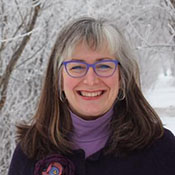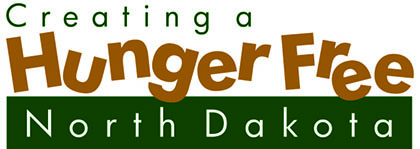ASK A RESEARCHER
September 2020
North Dakota Families are Facing Food and Other Hardships in the Wake of COVID-19 Pandemic, and Helpers Respond

Karen Ehrens is a health and nutrition consultant, registered dietitian, and policy advocate. She is coordinator for the Creating a Hunger Free North Dakota Coalition, connecting people and organizations working toward the vision of a hunger-free state. She gains hands-on understanding of how state and local policy impacts people in her community and state as a volunteer serving meals in local soup kitchens, delivering meals to seniors and those with health conditions, serving on the boards of the BisMarket Farmers Market and the North Dakota Local Foods Development Alliance. Karen has worked as an advocate to protect safety net programs with consumer, family, institutional health care, farm and faith-based groups through organizing and communication.
Karen holds a Certificate in Public Health from the University of Minnesota, and obtained undergraduate degrees from ND State University and Minot State University. Karen and her husband, a chef, teach cooking classes together, and live in Bismarck, ND with their daughter.
This year, 2020, has brought many changes to the people in our state and across the country. The COVID-19 pandemic and ensuing slowdown of human and economic activity has resulted in increased hardships for people in every state, with food insecurity and hunger among them.
Food Insecurity Indicators
Food insecurity is an area of increase and concern in North Dakota. Prior to the start of the pandemic, for the period of 2016-2018, people in about 28,700 North Dakota households, or around 9.0 percent of households, experienced food insecurity. Food insecurity means that people do not have enough food for a healthy and active life. This rate was among the lowest in the United States at the time. However, several indicators show changes in food availability, food affordability, and emergency food assistance, during the pandemic, in North Dakota.
Since March, 2020, many of us have entered a grocery store and have not been able to purchase what we wanted or needed. There have been changes in where we purchase food: less food purchased at restaurants, and more food purchased to prepare and eat at home. For comparison, in 2018, household spending on food in the United States was nearly equally divided between food eaten at home and food eaten away from home. In addition, shut-downs at food processing plants, ill and quarantined food workers, and strains in transportation of food, all contributed to empty shelves in grocery stores; this was a first-time experience for many North Dakotans.
The cost of food has also increased. Nationally, in April, 2020, the price of food increased 2.6 percent on average. This was the biggest monthly increase in the price of food in nearly 50 years. Price increases of 4.3 percent for meats, poultry, fish and eggs, 1.5 percent for fruits and vegetables, and 2.9 percent for cereals and bakery products were documented by the U.S. Bureau of Labor Statistics.
The Great Plains Food Bank has seen more than 40 percent increase in clientele at food pantries and mobile food distributions across North Dakota. Local partner agencies observed that this is the first time many people have had to seek help with food for their families. Forty-four percent of 11,300 North Dakotans who completed a statewide survey on impacts of COVID-19, administered by the North Dakota Department of Commerce, shared that hunger/food insecurity was an issue of concern in their communities.
Families with Children Especially Impacted
North Dakota families with children have been especially impacted by COVID-19 and its economic ripple effects. To help understand the impacts to North Dakota households, with the help of North Dakota Compass, I undertook to analyze a new data collection tool made available by the U.S. Census Bureau and several other government agencies. The Household Pulse Survey, a new online survey, was launched in April, 2020, to get a read on the social and economic situations during the global COVID-19 pandemic. Following is a summary of responses from North Dakotans for the first 10 weeks of the survey, beginning the last week of April through the first week of July, 2020.
- Eating more at home: Families with children who report recent food insufficiency are spending 2 – 4 times as much on food eaten at home as they are on food eaten outside the home.
- Not enough food or not of the type wanted: One-third to one-half of adults with children in their families reported recent food insufficiency in the last 7 days prior to answering the survey (enough food but not always the type wanted, sometimes not enough to eat, often not enough to eat, or did not report).
- Unable to afford food: Families reported that children were not eating enough because food was unaffordable; this was “often the case” in 1 – 15 percent of families, and “sometimes the case” in 19 – 43 percent of families with children who reported recent food insufficiency.
- Not confident finding food in coming weeks: Out of the families with children who report recent food insufficiency, 5 – 31 percent were “not at all confident” that they would be able to afford food over the next 4 weeks. In addition, 21 – 40 percent were only “somewhat confident” that they would be able to afford food over the next 4 weeks.
Finding Food Help
Fortunately, there are many “food helpers” in our communities that have sprung to action to provide food aid. Again, from the Household Pulse Survey, for families with children who reported food insufficiency, up to one-fourth of them obtained free groceries or free meal(s) in the 7 days prior to answering the survey. People who obtained free groceries or meals relied heavily on food provided by schools, followed by food panties/food banks, and help from family, friends, and neighbors.
- In 7 out of 10 weeks, 54% - 94% of families found food at school or other programs aimed at children;
- In 7 out of 10 weeks, 26% - 50% of people relied on food pantries/food banks;
- In 2 out of 10 weeks, 52% - 60% got help from family, friends, or neighbors.
State and local government agencies that administer federal food and nutrition programs have adapted the way they help those in need. State agencies, such as the North Dakota Department of Human Services, which administers the Supplemental Nutrition Assistance Program (SNAP), and the Administration for Community Living programs including community “congregate” meals and home delivered meals, requested and received waivers from federal agencies to change the way they operate, allowing curbside pick-up of meals, remote work, fewer employment requirements for SNAP participants, emergency supplemental SNAP benefits, and pandemic benefits for families with children who didn’t have access to school meals. The North Dakota Department of Health, which administers the Special Supplemental Nutrition Assistance Program for Women, Infants and Children (WIC), sought waivers to be able to provide assistance and education delivered online, and waiver of the requirement for in-person office visits. The North Dakota Department of Public Instruction, which administers school and childcare meal programs in the state, sought waivers to allow schools to provide meals by pick-up, to provide meals in the summer from school sites, to provide more than one meal at a time, and to be able to serve all children free meals.
Schools across North Dakota quickly shifted to “to-go” meals delivered out of school buses, and sometimes even delivered to homes. The Great Plains Food Bank helped its partners deliver food following safety and distance guidelines and arranged to be part of the USDA Farms to Families Food Box Program at multiple locations across the state on a weekly basis. Senior meal programs in both rural and more urban communities started providing meals “to-go” and increasing home meal deliveries with the help of volunteers. Rural grocery stores helped ensure that access to food can be found closer to home, and in a way that reduces risk of spread of COVID-19. Families, friends, and volunteers have stepped up to share food and to donate food or funds to area food pantries, soup kitchens and backpack programs. Gardeners and growers are donating garden produce through the Hunger Free North Dakota Garden Project, and once hunting season begins, hunters can donate goose or deer meat through the Sportsmen Against Hunger Program.
New programs utilizing federal funding allocated to North Dakota through the federal CARES Act will make available grants to increase access to food and to increase food infrastructure for perishable foods. The SNAP Access Enhancement Grant program, administered by the North Dakota Department of Human Services, will help equip North Dakota grocery stores and other retailers to accept SNAP electronic benefit transfer (EBT) card payments. A second grant program, administered by the North Dakota Department of Agriculture, will provide grants to charitable feeding organizations and rural grocers in towns of fewer than 750 people to extend the shelf life of perishable foods through the purchase of coolers, freezers or other equipment.
Agencies have joined forces over the last 11 years as part of the Creating a Hunger Free North Dakota Coalition. The CHFND Coalition is a statewide network of organizations, agencies and individuals established to collectively identify and address the unmet food and hunger needs and their underlying causes to meet the vision of a hunger-free North Dakota. People seeking help with food can find connections and information at the website, www.hungerfreend.org
September, traditionally recognized as “Hunger Action Month,” is a meaningful time to join in stepping up to help. Find ideas for how to reduce hunger in North Dakota here.

References:
Economic Research Report No. (ERR-270), Household Food Security in the United States in 2018,
September 2019, U.S. Department of Agriculture
https://www.ers.usda.gov/publications/pub-details/?pubid=94848
America’s Eating Habits: Food Away From Home, September 2018, U.S. Department of Agriculture
https://www.ers.usda.gov/webdocs/publications/90228/eib-196.pdf
US Bureau of Labor Statistics
https://www.bls.gov/news.release/cpi.t01.htm?mod=article_inlin
Letter to the Editor, Steve Sellent, Chief Executive Officer, Great Plains Food Bank, in the
Bismarck Tribune, August 9, 2020
https://bismarcktribune.com/opinion/letters/letter-temporary-increase-to-snap-benefits-needed/article_f598957b-8b62-5ffa-8e04-4957ff5117bd.html
North Dakota Department of Commerce
https://ndresponse.gov/covid-19-resources/covid-19-business-and-employer-resources/financial-resources/communities
The Household Pulse Survey, U.S. Census Bureau, https://www.census.gov/householdpulsedata
